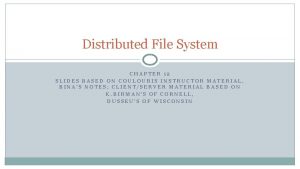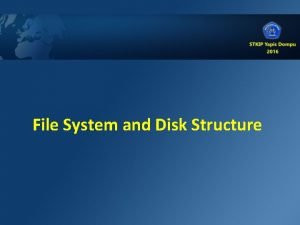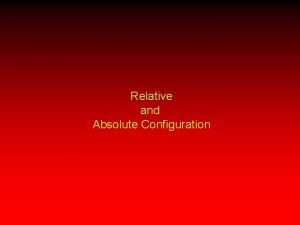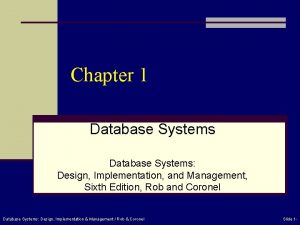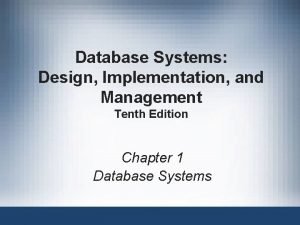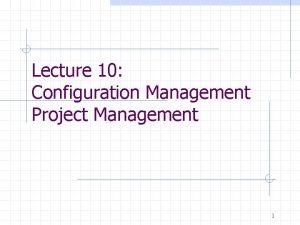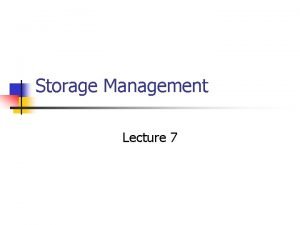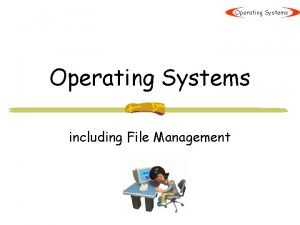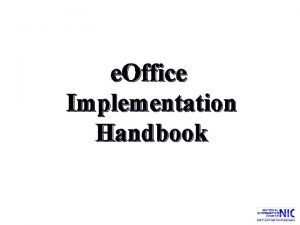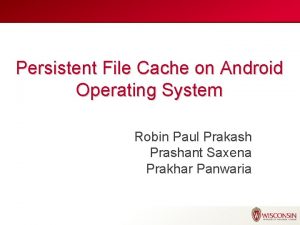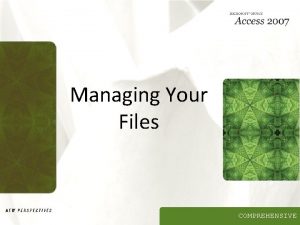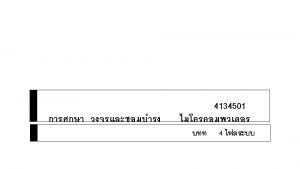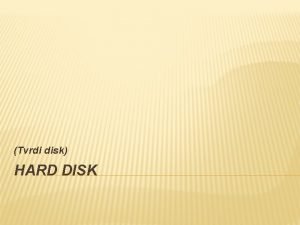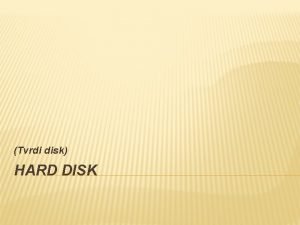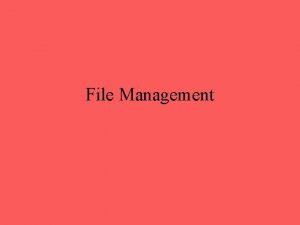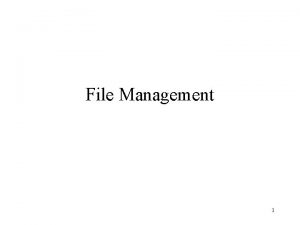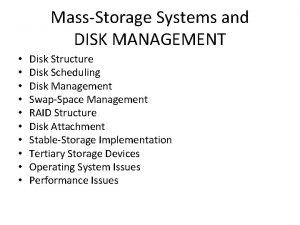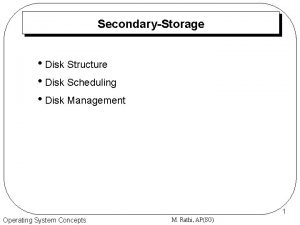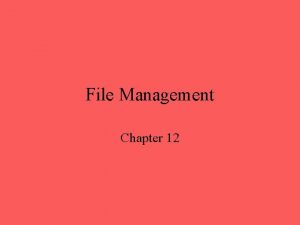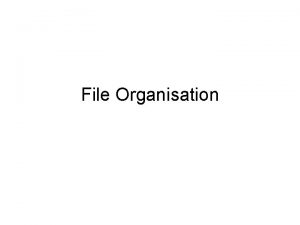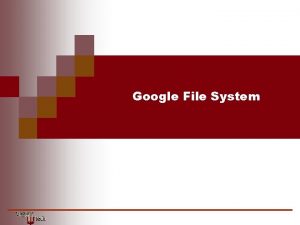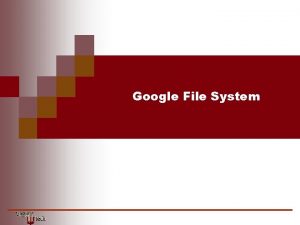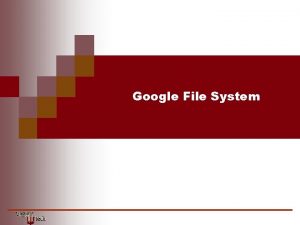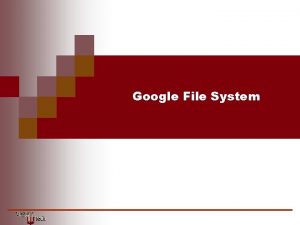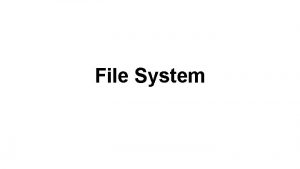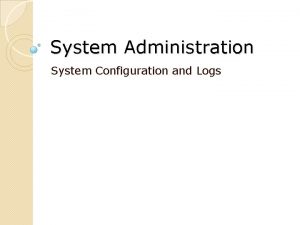File System Implementation and Disk Management disk configuration





















- Slides: 21

File System Implementation and Disk Management § § disk configuration and typical access times selecting disk geometry evolution of UNIX file system improving disk performance • using caching • using head scheduling 1

On previous lecture § § seek time — time required to position heads over the track / cylinder • typically 10 ms to cross entire disk rotational delay — time required for sector to rotate underneath the head • 120 rotations / second = 8 ms / rotation 2

Disk Access Times § § § typically on a disk: • 32 -64 sectors per track • 1 K bytes per sector data transfer rate is number of bytes rotating under the head per second • 1 KB / sector * 32 sectors / rotation * 120 rotations / second = 4 MB / s disk I/O time = seek + rotational delay + transfer • If head is at a random place on the disk F avg. seek time is 5 ms F avg. rotational delay is 4 ms F data transfer rate for a 1 KB is 0. 25 ms F i/o time = 9. 25 ms for 1 KB F real transfer rate is roughly 100 KB / s • in contrast, memory access may be 20 MB / s (200 times faster) 3

Disk Hardware (cont. ) § § typical disk today (Compaq 40 GB Ultra ATA 100 7200 RPM hard disk = $369): • 16383 cylinders, 16 heads, 63 sectors/track • 16 platters * 16383 tracks/platter * 63 sectors/track * 4048 bytes/sector * F 1/1024^3 GB/byte = 63 GB unformatted • 7200 rpm spindle speed, 8 ms average seek time, 100 MBps data transfer rate trends in disk technology • disks get smaller, for similar capacity – faster data transfer, lighter weight • disk are storing data more dense – faster data transfer • density improving faster than mechanical limitations (seek time, rotational delay) • disks are getting cheaper (factor of 2 per year since 1991) 4

Selecting Sector Size (cont. ) § § using big sectors sounds like a good idea, but • most files are small, maybe one block • big blocks cause internal fragmentation some measurements from a file system at UC Berkeley: • Organization Space used • data only 775. 2 • +inodes, 512 B block 828. 7 • +inodes, 1 KB block 866. 5 • +inodes, 2 KB block 948. 5 • +inodes, 4 KB block 1128. 3 Waste 0% 6. 9% 11. 8% 22. 4% 45. 6% 5

Storing Data on Circular Media sectors on the inner tracks have shorter length. problem § cannot read/write faster than in outer track (outer tracks may move faster under read/write head solutions § constant angular velocity (CAV) – different speed on different tracks, simpler motor mechanism – used on most modern hard drives • observation: most of waste happens on the outer tracks, partial-CAV (p-CAV or CAV/CLV) - two zones, inner – CAV, outer – CLV – used for some CD-ROM/DVD drives § constant linear velocity (CLV) – changes disk speed rotation with each track – complicated rotation mechanism, imprecise change • variant zone-CLV (Z-CLV) - breaks cylinders into zones, changes speed by zone problem § cannot write denser than in inner tracks – potentially sparse data on outer track solution § constant bit recoding – same number of sectors on all cylinders § zone bit recording (ZBR) – break cylinders into zones, change number of sectors per zone. If CAV, the data transfer rate is higher on outer cylinders – may be a benefit (store metadata there) • most modern disks are ZBR 6

Recall The File System Organization disk drive partition bootb. superb. File’s inode ilist inode directory blocks and file data blocks inode pointer File attributes inode # name block # . . . block # inode # name . . . dir’s block 1 st indirect block # 1 st indirect block dir’s inode dir. attributes block # . . . block # block Directory and file data blocks block 7

Traditional Unix File System § in traditional UNIX (System V FS), and Berkeley BSD 3. 0 UNIX • disk lock size was 512 bytes • i-list follows superblock, has limited size determined at formatting (limits the number of files on system • directory contains fixed size records 16 bytes each (first two - i-node number, the rest - file name) • free blocks maintained in a linked list, superblock contains pointer to first § problems with System V FS: • one superblock - becomes corrupted - filesystem unusable • all I-nodes at the beginning of disk - reading files requires accessing I-nodes random disk access pattern • files blocks are allocated at random • practical measurements: when file system was first created F free list was ordered, and they - transfer rates up to 175 KB / s F after a few weeks data and free blocks got so randomized - to 30 KB / s; less than 4% of the maximum transfer rate! • 14 character names insufficient 8

Unix Fast-File System § in Berkeley BSD 4. 2 UNIX: • see “A Fast File System for UNIX” on class home page for details • introduced cylinder group – a set of adjacent cylinders F each cylinder group has a copy of super block, bit map of free blocks, ilist, and blocks for storing directories and files • the OS tries to put related information together into the same cylinder group F try to put all i-nodes in a directory in the same cylinder group F try to put i-node and file blocks in the same cylinder group F try to put blocks for one file contiguously in the same cylinder group: bitmap of free blocks makes this easy • however, OS tries to spread the load between cylinder groups (otherwise all disk – one cylinder group) F for long files, redirect each megabyte to a new cylinder group F puts directory and its subdirectories in different groups) 9

Unix FFS (cont. ) § § block size was changed to 4096 bytes • reduced fragmentation as follows: F each disk block can be used in its entirety, or can be broken up into 2, 4, or 8 fragments F for most of the blocks in the file, use the full block F For the last block in the file, use as small a fragment as possible F can get as many as 8 very small files in one disk block • this change resulted in F only as much fragmentation as a 1 KB block size (w/ 4 fragments) F data transfer rates that were 47% of the maximum rate other improvements: • bit map instead of unordered free list - each bit corresponds to a fragment • variable length file names, symbolic links • file locking, disk quotas 10

File System Recovery disk drive partition bootb. superb. File’s inode File attributes block # . . . 1 st indirect block # 1 st indirect block ilist directory blocks and file data blocks . . . block # dir’s inode dir. attributes is it possible to restore a inode filesystem if the following pointer structures are corrupted? inode # name • superblock dir’s. . . • ilist block inode # name • directory listing • individual inode • block free list block # partition block most OSes check consistency blockeither automatically of a filesystem Directory and file (on boot) or on demand data blocks block 11

Efficient Block Management § § OS keeps track of free blocks on the disk using a bit map • bit map – an array of bits u 1 – the block is free, u 0 – the block is allocated to a file • For a 1. 2 GB drive, there about 307, 000 4 KB blocks, so a bit map takes up 38. 4 KB (usually kept in memory) • modern comp. architectures provide instructions for quick bitmap manipulation – one instruction returns the offset of the first zero efficient to allocate related blocks closer to each other • problematic if disk is nearly full u solution — keep some space (about 5 -10% of the disk) in reserve, and don’t tell users; never let disk get more than 90% full u spread the load to make sure that disk fills up uniformly across cylinders 12

Extent-Based Allocation, Journaling § extent-based allocation • rather than refer to individual data blocks the index blocks specifies the beginning of an extent of continuously allocated blocks and the number of blocks in the extent F advantages - faster disk access, fewer indirections (combines the advantages of continuous and indexed allocation) F disadvantages – extra effort to select extend size, possible since modern FS keep free lists as bits § journaling (in NTFS (Windows NT/XP) and UFS in modern Unices) • updating data entails multiple operations in several places: F slow, not robust in case of a crash • metadata (directories, pointers, free list, etc. ) needs to be updated • improvement: synchronously write changes to a file (called log or journal) and then asynchronously to all needed places on disk F advantage: sequential synchronous write instead of distributed asynchronous one 13

Unified Buffer Cache § § OS caches disk blocks to improve performance • when OS reads a file from disk, it copies those blocks into the cache • before OS reads a file from disk, it first checks the cache to see if any of the blocks are there (if so, uses cached copy) page cache (Solaris, new Linux, XP) • storing files info as pages is more efficient than as blocks – can apply virtual memory techniques, if so – no reason to differentiate • unified buffer cache – combined (process and file I/O) paging what page replacement to use? F a variant of LRU seems good F optimization for files for sequential access • free behind – discards page as soon as it is read • read ahead – pages are read in advance 14

Disk Head Scheduling § § § permute the order of the disk requests • from the order that they arrive in • into an order that reduces the distance of seeks examples: • head just moved from lower-numbered track to get to track 30 • request queue: 61, 40, 18, 78 algorithms: • first-come first-served (FCFS) • shortest seek time first (SSTF) • SCAN (0 to 100, 100 to 0, …) • C-SCAN (0 to 100, …) • LOOK (lowest-highest, highest-lowest) • C-LOOK (lowest-highest, lowest-highest) 15

Disk Head Scheduling (cont. ) FCFS - handle in the order of arrival 0 § § 10 20 30 40 50 60 70 80 90 100 advantages: simple, fair disadvantages: can use disk inefficiently (if one process is using file on outer track, and another process is using file on inner track, will be many long seeks) 16

Disk Head Scheduling (cont. ) SSTF - select the request that requires the smallest seek from current track 0 § § 10 20 30 40 50 60 70 80 90 100 advantages: reduces arm movement, uses the disk rather efficiently disadvantages: • fairness: disk can stay in one area for a long time (result = starvation) 17

Disk Head Scheduling (cont. ) SCAN (elevator algorithm) - Move the head 0 to 100, 100 to 0, picking up requests as it goes 0 § § 10 20 30 40 50 60 70 80 90 100 advantages: better fairness (no starvation) problems • request on edge of disk just behind in direction traveling can wait a long time to be serviced (twice disk length) • even request in middle waits long time 18

Disk Head Scheduling (cont. ) LOOK (variant of SCAN) - don’t go to edges if there are no requests there 0 § 10 20 30 40 50 60 70 80 90 100 advantages: less wasted movement than SCAN 19

Disk Head Scheduling (cont. ) C-SCAN -Move the head 0 to 100, picking up requests as it goes, then big seek to 0 0 § 10 20 30 40 50 60 70 80 90 100 advantage: fairer than SCAN 20

Disk Head Scheduling (cont. ) C-LOOK -same as C-SCAN, don’t go to edge if not necessary 0 10 20 30 40 50 60 70 80 90 100 21
 File-file yang dibuat oleh user pada jenis file di linux
File-file yang dibuat oleh user pada jenis file di linux Distributed file system notes
Distributed file system notes Disk file system adalah
Disk file system adalah Remote file access in distributed file system
Remote file access in distributed file system In a file-oriented information system, a transaction file
In a file-oriented information system, a transaction file Relative configuration vs absolute configuration
Relative configuration vs absolute configuration Planar chirality
Planar chirality Electron configuration vs noble gas configuration
Electron configuration vs noble gas configuration Relative vs absolute configuration
Relative vs absolute configuration Database systems: design, implementation, and management
Database systems: design, implementation, and management Database system design implementation and management
Database system design implementation and management Difference between logical file and physical file
Difference between logical file and physical file Configuration management system pmp
Configuration management system pmp Software configuration items
Software configuration items Disk storage types
Disk storage types Fungsi sistem file
Fungsi sistem file Markup tag tells the web browser
Markup tag tells the web browser File management worksheet answers
File management worksheet answers E office implementation
E office implementation Android manifest persistent
Android manifest persistent What are the main components of file management
What are the main components of file management Objectives of file management system
Objectives of file management system

